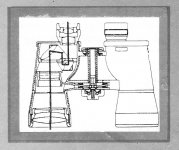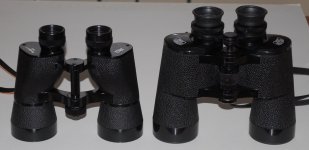Thanks for that info and diagram, Henry. I can see the focuser bridge at the bottom, but in this "x-ray view" I'm not sure where the focuser is located, on top or at the bottom like the Swaro SLs. There seems to be a shaft in the center going from top to bottom but I can't tell from the diagram if that's functional or just infrastructure.
As far as pricing, an internal focus Leica porro made today is going to be as expensive as a Leica roof (although roofs weren't nearly as good optically as porros 40 years ago due to the lack of p-/sliver/dielectric coatings, so I'm surprised you were disappointed at the Kern porro's performance).
If the unthinkable happened, and Leica, Zeiss, and Swaro started making high quality porros with internal focusers, they would no doubt be very pricey even though the "buzz" is that porros are easier to manufacturer (and the examples I gave of the two recent internal focus porros seem to support that as do the low price of porros today).
The more complex, wider FOV EPs would add some cost. Although curiously, you once said that the Zeiss FL
didn't have complex EPs, and I meant to ask you about that reference since it contradicts what you wrote in my "Incremental Change$" thread about alpha's complex EPs being one factor in alpha's high cost).
You also pay for the quality parts and engineering when you buy a German- or Austrian-made roof.
However, a goodly chunk of the costs involved are due to the high cost of labor in those countries and therefore also the high cost of materials. A Swaro rep admitted this to me so this is not my personal "speculation".
And it's no secret revelation, you can easily find references (and I've posted them on BF before) about Germany having the highest wages and highest cost of living in Europe, and Austria being the second in those categories. Those costs get passed on to the consumer.
However, I bet your buttons that if a Japanese or a Chinese bin manufacturer made an internal focuser porro with WF EPs, it wouldn't cost $2K (or at least it wouldn't
need to cost $2K).
So cost is not
the prohibitive factor in making good quality internal focuser porros with WF EPs. It can be done at competitive prices to alpha roofs.
But as John said above, porros were displaced due to roof's compactness and ergonomics. I would add to that the invention of p-coatings, which enabled roofs to come up to par, or nearly, with good quality porros.
That was the turning point and the beginning of the "heavy bombardment period" for porrosaurs.
Until optics manufacturers started making open bridge roofs, their compactness and ergonomics didn't have any appeal to me, because of my large hands.
I'm sure I'm not the only male birder with large hands, and I can't imagine that women drove the trend toward roofs. There are a lot of couples that bird together, but not nearly as many women hunters, and w/out broaching that subject again 'ere we should get off track with another moral discussion, most bins aimed at hunters are also roofs.
There may have been other factors that drove the Cambrian Roof Explosion besides p-coatings and women's and small handed men's preferences for compact design bin. Roof's superior waterproofness is undoubtedly one of those factors.
But what about the "roof mystique" that Stephen Ingraham and other reviewers have alluded to? How much of role did
that factor play in marketing roofs, and where did this "mystique" originate and what exactly is it???
mystique = An aura of heightened value, interest, or meaning surrounding something, arising from
attitudes and beliefs that impute special power or mystery to it.
I have some ideas about this, but I probably already lost Henry with my long post, and I know I lost Steve (mooreorless) after the first paragraph!

So e will probe the dark depths of that mystery another time, but I think solving that mystery might be the key to finding how to create a marketing "mystique" for internal focus porros.






